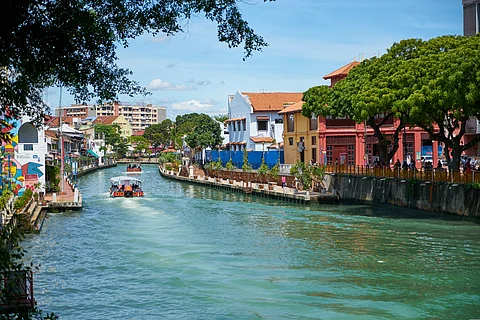
- Destinations
- Experiences
- Stay
- What's new
- Celebrating People
- Responsible Tourism
- CampaignsCampaigns
- SubscribeSubscribe
- Buy Now

From ancient caves to pristine beaches, the UNESCO World Heritage Sites in Malaysia are a must-see. Whether you’re hiking up the majestic Mount Kinabalu, exploring the charming streets of George Town, or uncovering the secrets of prehistoric Lenggong Valley, these sites offer a chance to learn about the country's culture, nature, and history. Outlook Traveller has picked the top five.
George Town (Penang) and Melaka were inscribed as UNESCO World Heritage Sites under the category of 'Cultural Heritage' in 2008. They are known for their rich historical, cultural, and architectural heritage, which entails the colonial past, local traditions, and the influences of Chinese, Malay, and European cultures.
While George Town is famous for its well-preserved colonial architecture, diverse street art, and sumptious food scene, Melaka offers a cluster of historical monuments, old colonial structures, and cultural landmarks, making it an important historical port city.
How to Get There:
George Town: Fly into Penang International Airport and complete the onward journey to the city center by road, which takes about 30 minutes.
Melaka: Fly into Kuala Lumpur International Airport (KLIA). From there, Melaka is roughly two hours by road.
Best Time to Visit: November to March is ideal for avoiding the heavy rain season, with dry weather and cooler temperatures.
Entry Charges:
George Town: Free entry to most areas, though some museums and attractions charge small fees (such as Pinang Peranakan Mansion is priced at around RM 20 or INR 370).
Melaka: The historical streets are free, but attractions like museums or historical sites are nominally priced (for example, a ticket at Stadthuys Museum is around RM 10 or INR 185).
Timings: Most sites are open daily, with museums generally open from 9:00 am to 5:00 pm.
Kinabalu Park was inscribed as Natural UNESCO World Heritage Site in 2000. It is home to Mount Kinabalu, the tallest mountain in Southeast Asia; and abundant biodiversity, boasting thousands of plant species, hundreds of bird species, and unique wildlife. The site is also a UNESCO biosphere reserve, making it a haven for nature lovers and hikers.
How to Get There: Fly into Kota Kinabalu International Airport, then continue onwards by road for roughly two hours to reach the park.
Best Time to Visit: March to September offers the best weather for hiking and exploring, as the temperatures are cooler and there’s less rainfall.
Entry Charges:
Adult (Malaysian): RM 15 / INR 275
Adult (International): RM 30 / INR 550
Climbing Mount Kinabalu: The costs are around RM 400-500 / INR 7,500-9,500 depending on the package (entrance, guides, and permits).
Timings:
Kinabalu Park is open from 7:00 am to 5:00 pm.
Should you wish to climb, reach early with a mandatory permit that must be booked in advance. You'll reach the summit by early noon.
Gunung Mulu National Park was listed as a UNESCO World Heritage Site in 2000 for its outstanding natural beauty. The park is known for its limestone karst formations, vast cave systems (including the world’s largest cave chamber), and biodiversity. The Deer Cave and Lang Cave are some of the park’s most famous attractions, with breathtaking formations and thousands of bats completing the scene.
How to Get There: Take a connecting flight to Mulu Airport, the closest airport near Gunung Mulu National Park.
Best Time to Visit: March to October is ideal for visiting, avoiding the monsoon season (November to February).
Entry Charges:
RM 30 for adults / INR 550
Cave tours are typically priced at RM 30-50 / INR 550-900, depending on the tour type.
Timings: Mulu Park is open from 8:00 am to 5:00 pm. Cave tours typically start in the morning, but check with the park for exact schedules.
Langkawi Geopark was designated as a UNESCO Global Geopark in 2007. Its geological features include ancient limestone formations, pristine beaches, and diverse ecosystems, making it a place of preference for nature lovers and those interested in geology. The park houses rainforests, mangroves, and coastal areas, plus the famous Sky Bridge and Langkawi Cable Car.
How to Get There: Fly into Langkawi International Airport, the closest airport.
Best Time to Visit: November to March is the best time to visit, as the weather is dry and pleasant.
Entry Charges:
Langkawi Cable Car: RM 35 / INR 650 for adults.
Sky Bridge: RM 5 / INR 90
Timings: Langkawi Cable Car operates from 10:00 am to 7:00 pm, while the Geopark is open year-round for exploration.
The Lenggong Valley was added to the UNESCO World Heritage list in 2012 for its archaeological significance. The valley is home to prehistoric caves with some evidence of ancient human settlements. It is considered one of the most important archaeological sites in Southeast Asia, with artefacts dating back over 1.8 million years. Two of the key sites here include the Perak Man, a 10,000-year-old human skeleton, and Bukit Kepala Gajah.
How to Get There: Fly into Kuala Lumpur International Airport and drive to the valley. The road journey takes about three to four hours.
Best Time to Visit: March to October is ideal, as the weather is relatively pleasant during these months.
Entry Charges: Entry to the site is generally free, but certain attractions or museums charge RM 5-10 / INR 90-185 for entry.
Timings: Lenggong Valley is an open site, but visiting museums or archaeological sites may require adherence to specific hours, usually from 9:00 am to 5:00 pm.
